标签:tensor key inf 效果 数据 span 双线性插值 符号 oat
这两天新型肺炎病例是指数上升啊!呆在家里没事干,正好想起之前FPGA大赛上有个老哥做了一个图像旋转作品,还在群里发了技术报告。无聊之下就打算学习一下,然后就顺便把平移、旋转、缩放这些几何变换都看了,最后决定把这三个综合起来写个“旋转傻乌龟”的动画。先是用OpenCV内置函数实现了下,感觉不过瘾,又自己写了一遍。老规矩,还是把学过的、做过的东西记录下来!
旋转傻乌龟,效果就是将一只乌龟在窗口中同时进行平移、缩放和旋转,由于最后看起来样子比较傻,因此得名“旋转傻乌龟”。
效果视频:

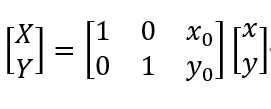
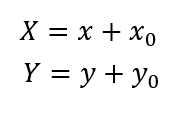
上图中的三种表示方法第二种是OpenCV要求的方式,但第一种形式表示起来更具统一性,因此我更倾向于第一种。但无论哪一种,都能展开成第三种的形式。第三种非常直观的反映了平移,只是需要注意正负号的选取——在编程中,图像一般以左上角为(0,0)点。这也就是说,建立坐标系的时候,X轴以右正方向,Y轴以下为正方向。以上矩阵表示将图像向右平移x0,向下平移y0,也可以认为是将坐标系向左平移x0,向上平移y0。平移可以形象地表示如下:
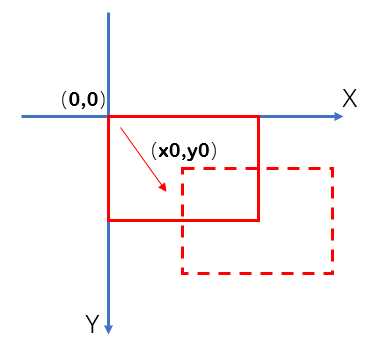
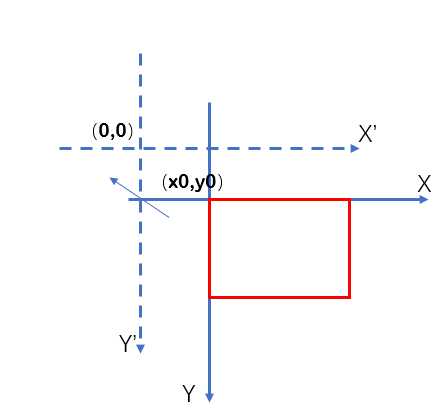
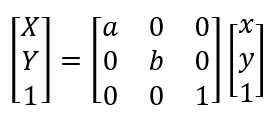
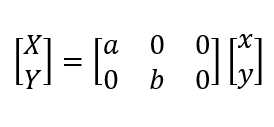
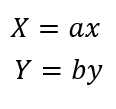
缩放最容易理解,就是将横纵坐标乘以缩放比例。由于我们以左上角为坐标系原点,所以左上角点的位置并不会变化。


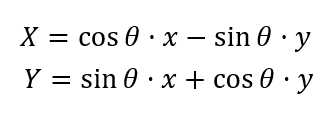
在本文中,规定顺时针方向旋转,θ为正;逆时针旋转,θ为负。旋转前后的坐标关系推导也不难,如下图所示,旋转前先求出旋转半径L,旋转后根据L求出坐标。
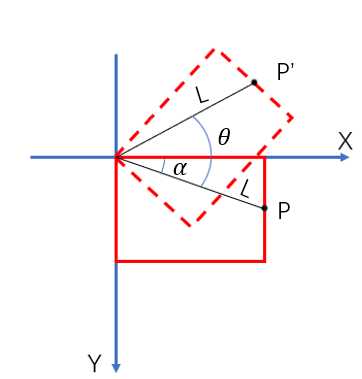
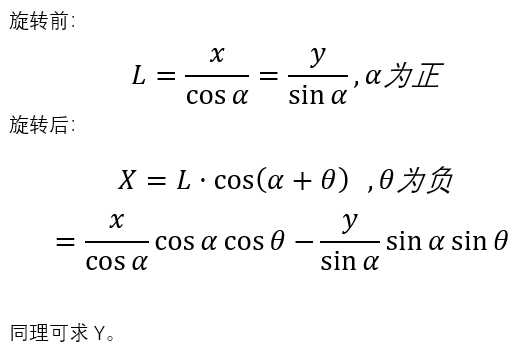
为了之后表述的简洁,我们将这三节中的矩阵分别用特定符号简记:
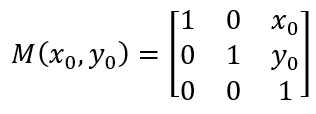
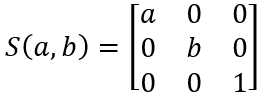

有了以上的基础,我们就可以研究更加复杂的变换。例如我们想以任一点(x0,y0)为中心旋转,而我们推导的R(θ)只适用于以坐标系原点为中心旋转。因此,我们可以将图像向上平移x0,向左平移y0,使(x0,y0)点平移到坐标系原点;然后再旋转,旋转完后再向下平移x0,向右平移y0回到原来位置,这一过程可用三个基础基础矩阵表示成如下形式,注意三个矩阵顺序不能调换。

方法同1.4节的旋转,可以表示为下面形式。除此之外,还可以在此基础上进行旋转平移,只要在左边依次乘上相应矩阵即可。

OpenCV提供了仿射变换函数warpAffine。在输入参数中,M表示变换矩阵,可以是平移、旋转和缩放矩阵等;dsize是输入图像的大小;flags是插值方式,一般采用默认的双线性插值。

至于M的获取,平移矩阵只能自己构造;二旋转矩阵可以由函数getRotationMatrix2D得到。输入参数中,center表示旋转中心的坐标;angle为旋转角度,逆时针为正;scale是缩放比例。可见这个函数同时包揽了旋转和缩放的功能。

我的思路是,用正弦函数生成一系列轨迹点,乌龟每到达一个轨迹点,就旋转一定角度,缩放一定比例,而轨迹点的跟踪就是乌龟中心的平移。根据之前的说的原理,我们先让整个图像绕自身中心旋转和缩放,缩放后的乌龟应该是在整个图像的中间,为了让它中心和轨迹重合,就使用平移变换,此时平移的距离应该是path-center。整个过程的代码如下:
1 import cv2 2 import numpy as np 3 import time 4 5 img = cv2.imread(‘image/turtle.jpg‘) 6 size = img.shape[:-1] 7 cv2.namedWindow(‘img‘) 8 9 #平移矩阵 10 def GetMoveMatrix(x,y): 11 M = np.zeros((2, 3), dtype=np.float32) 12 13 M.itemset((0, 0), 1) 14 M.itemset((1, 1), 1) 15 M.itemset((0, 2), x) 16 M.itemset((1, 2), y) 17 18 return M 19 20 if __name__ == ‘__main__‘: 21 22 # shape和坐标是颠倒的 23 center_x = size[1]/2 24 center_y = size[0]/2 25 #计时 26 start_time = time.time() 27 28 for x in np.linspace(0,2*np.pi,100): 29 #角度、缩放 30 angle = -360*x/2/np.pi 31 scale = 0.2+0.2*np.sin(x) 32 #轨迹 33 path_x = x*50+100 34 path_y = (np.sin(x)+1)*100+100 35 #旋转、平移矩阵 36 M1 = cv2.getRotationMatrix2D((center_x, center_y), angle, scale) 37 M2 = GetMoveMatrix(path_x-center_x,path_y-center_y) 38 #仿射变换 39 rotate = cv2.warpAffine(img,M1,size) 40 dst = cv2.warpAffine(rotate,M2,size) 41 42 # cv2.imshow(‘img‘,dst) 43 # cv2.waitKey(1) 44 #花费125ms 45 print(time.time()-start_time)
这个自己用Python实现的话,性能就相当重要了,尤其是双线性插值,如果不优化的话,慢得简直可以让你怀疑人生。比如,一般的是用两个for循环迭代,代码如下。在这个项目里,这个函数执行一次需要花费1.4s的时间。所以不优化的话,这只乌龟真的是名副其实了!
1 def InterLinearMap(img,size,mapx,mapy): 2 3 dst = np.zeros(img.shape,dtype=np.uint8) 4 5 for row in range(size[0]): 6 for col in range(size[1]): 7 8 intx = np.int32(mapx.item(row,col)) 9 inty = np.int32(mapy.item(row,col)) 10 partx = mapx.item(row,col)-intx 11 party = mapy.item(row,col)-inty 12 resx = 1-partx 13 resy = 1-party 14 15 if party==0 and partx==0: 16 result=img[inty,intx] 17 else: 18 result = ((img[inty,intx]*resx+img[inty,intx+1]*partx)*resy 19 +(img[inty+1,intx]*resx+img[inty+1,intx+1]*partx)*party) 20 21 dst[row,col]=np.uint8(result+0.5) 22 23 return dst
那怎么办?网上有一些优化的方法,主要是将浮点运算转成整数运算,这个方法对于FPGA这样的逻辑器件最适合不过了——但别忘了,我现在用的是Python,整数运算实际上也会被转成浮点运算,所以这个方法显然不适用。我采用的优化是进行矩阵化,据我所知,很多编程语言只要是支持矩阵运算的,其运算都是优化过的。对于双线性插值和仿射变换,运用矩阵也是很合适,只是写起来会有点抽象。。。
首先,先把生成变换矩阵的函数写出来,代码如下。要注意numpy的三角函数接受的参数是弧度制。
1 #缩放矩阵 2 def GetResizeMatrix(scalex,scaley): 3 M = np.zeros((3,3),dtype=np.float32) 4 5 M.itemset((0,0),scalex) 6 M.itemset((1,1),scaley) 7 M.itemset((2,2),1) 8 9 return M 10 #平移矩阵 11 def GetMoveMatrix(x,y): 12 M = np.zeros((3, 3), dtype=np.float32) 13 14 M.itemset((0, 0), 1) 15 M.itemset((1, 1), 1) 16 M.itemset((2, 2), 1) 17 M.itemset((0, 2), x) 18 M.itemset((1, 2), y) 19 20 return M 21 #旋转矩阵 22 def GetRotationMatrix(angle): 23 M = np.zeros((3, 3), dtype=np.float32) 24 25 M.itemset((0, 0), np.cos(angle)) 26 M.itemset((0, 1), -np.sin(angle)) 27 M.itemset((1, 0), np.sin(angle)) 28 M.itemset((1, 1), np.cos(angle)) 29 M.itemset((2, 2), 1) 30 31 return M
接下来写仿射变换函数,输入参数为图片数据、变换矩阵和输入图片的大小。这里应该要有逆向思维——现在我要得到变换后的图片,就是要求各坐标位置上的色彩,而色彩取样自变换前图像上的一点(这点的坐标可能不是整数),也就是说我们要将变换后的坐标映射到变换前的坐标。再来看之前的公式(下图左,为了方便,将变换矩阵合成为一个矩阵A),现在我们已知的是左边部分,而要求的映射是等式右边的XY,因此我们将A拿到左边,得到另一个公式(下图右),并依据这个公式,写出仿射变换函数。
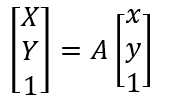
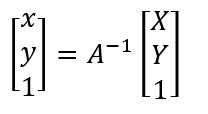
1 def WarpAffine(img,Mat,size): 2 3 rows = size[0] 4 cols = size[1] 5 #生成矩阵[X Y 1] 6 ones = np.ones((rows, cols), dtype=np.float32) 7 #gridx/gridy -> shape(rows,cols) 8 gridx,gridy= np.meshgrid(np.arange(0, cols),np.arange(0, rows)) 9 #dst -> shape(3,rows,cols) 10 dst = np.stack((gridx, gridy, ones)) 11 12 #求逆矩阵 M -> shape(3,3) 13 Mat = np.linalg.inv(Mat) 14 #获得矩阵[x,y,1] -> shape(3,rows,cols) 15 src = np.tensordot(Mat,dst,axes=[[-1],[0]]) 16 17 #mapx/mapy -> shape(rows,cols) 18 mapx = src[0]#坐标非整数 19 mapy = src[1]#坐标非整数 20 #仿射出界的设为原点 21 flags = (mapy > rows - 2) + (mapy < 0) + (mapx > cols - 2) + (mapx < 0) 22 mapy[flags] = 0 23 mapx[flags] = 0 24 #双线性插值 25 26 result = InterLinearMap(img, mapx, mapy) 27 28 return result
再解决双线性插值,关于该算法的原理挺简单的,读者可以网上查找(提一点,理解双线性插值时可以想象3D模型,Z轴为灰度值)。对于该函数,借鉴一下remap函数,输入参数设两个map,分别表示x,y的映射。map的大小跟图片大小相同,也就是说,一共有rows*cols点需要插值,除了用两个for迭代,我们也可以将rows和cols作为矩阵的两个额外维度,表示样本数。计算的话,利用矩阵的点乘代替凌乱的长算式,显得很简洁,公式如下:

代码如下,经测试,执行一次该函数,花费时间为45ms,这要比原来的1.4s快多了(实在不知道该怎么进一步优化了,mxy、img下表索引、求和各花了15ms)
def InterLinearMap(img,mapx,mapy): #(rows,cols) inty = np.int32(mapy) intx = np.int32(mapx) nxty = 1+inty nxtx = 1+intx #(rows,cols) party = mapy - inty partx = mapx - intx resy = 1-party resx = 1-partx #(4,rows,cols) mxy = np.stack((resy*partx,resy*resx,partx*party, resx*party)) mxy = np.expand_dims(mxy,axis=-1) #(4,rows,cols,3) mf = np.stack((img[inty,nxtx],img[inty,intx],img[nxty,nxtx],img[nxty,intx])) #res -> shape(rows,cols,3) res = np.sum(mxy*mf,axis=0) res = np.uint8(res+0.5) return res
综上,给出完整代码:
import cv2 import numpy as np img = cv2.imread(‘image/turtle.jpg‘) size = img.shape[:-1] cv2.namedWindow(‘img‘) #缩放矩阵 def GetResizeMatrix(scalex,scaley): M = np.zeros((3,3),dtype=np.float32) M.itemset((0,0),scalex) M.itemset((1,1),scaley) M.itemset((2,2),1) return M #平移矩阵 def GetMoveMatrix(x,y): M = np.zeros((3, 3), dtype=np.float32) M.itemset((0, 0), 1) M.itemset((1, 1), 1) M.itemset((2, 2), 1) M.itemset((0, 2), x) M.itemset((1, 2), y) return M #旋转矩阵 def GetRotationMatrix(angle): M = np.zeros((3, 3), dtype=np.float32) M.itemset((0, 0), np.cos(angle)) M.itemset((0, 1), -np.sin(angle)) M.itemset((1, 0), np.sin(angle)) M.itemset((1, 1), np.cos(angle)) M.itemset((2, 2), 1) return M def InterLinearMap(img,mapx,mapy): #(rows,cols) inty = np.int32(mapy) intx = np.int32(mapx) nxty = 1+inty nxtx = 1+intx #(rows,cols) party = mapy - inty partx = mapx - intx resy = 1-party resx = 1-partx #(4,rows,cols) mxy = np.stack((resy*partx,resy*resx,partx*party, resx*party)) mxy = np.expand_dims(mxy,axis=-1) #(4,rows,cols,3) mf = np.stack((img[inty,nxtx],img[inty,intx],img[nxty,nxtx],img[nxty,intx])) #res -> shape(rows,cols,3) res = np.sum(mxy*mf,axis=0) res = np.uint8(res+0.5) return res def WarpAffine(img,Mat,size): rows = size[0] cols = size[1] #生成矩阵[X Y 1] ones = np.ones((rows, cols), dtype=np.float32) #gridx/gridy -> shape(rows,cols) gridx,gridy= np.meshgrid(np.arange(0, cols),np.arange(0, rows)) #dst -> shape(3,rows,cols) dst = np.stack((gridx, gridy, ones)) #求逆矩阵 M -> shape(3,3) Mat = np.linalg.inv(Mat) #获得矩阵[x,y,1] -> shape(3,rows,cols) src = np.tensordot(Mat,dst,axes=[[-1],[0]]) #mapx/mapy -> shape(rows,cols) mapx = src[0]#坐标非整数 mapy = src[1]#坐标非整数 #仿射出界的设为原点 flags = (mapy > rows - 2) + (mapy < 0) + (mapx > cols - 2) + (mapx < 0) mapy[flags] = 0 mapx[flags] = 0 #双线性插值 result = InterLinearMap(img, mapx, mapy) return result if __name__ == ‘__main__‘: center_x = size[1]/2 center_y = size[0]/2 for x in np.linspace(0,2*np.pi,100): angle = 360*x/2/np.pi scale = 0.2+0.2*np.sin(x) path_x = x*50+100 path_y = (np.sin(x)+1)*100+100 M = GetMoveMatrix(path_x,path_y)@GetRotationMatrix(x) @GetResizeMatrix(scale,scale)@GetMoveMatrix(-center_x,-center_y) dst = WarpAffine(img,M,size) cv2.imshow(‘img‘,dst) cv2.waitKey(1)
标签:tensor key inf 效果 数据 span 双线性插值 符号 oat
原文地址:https://www.cnblogs.com/kensporger/p/12236869.html